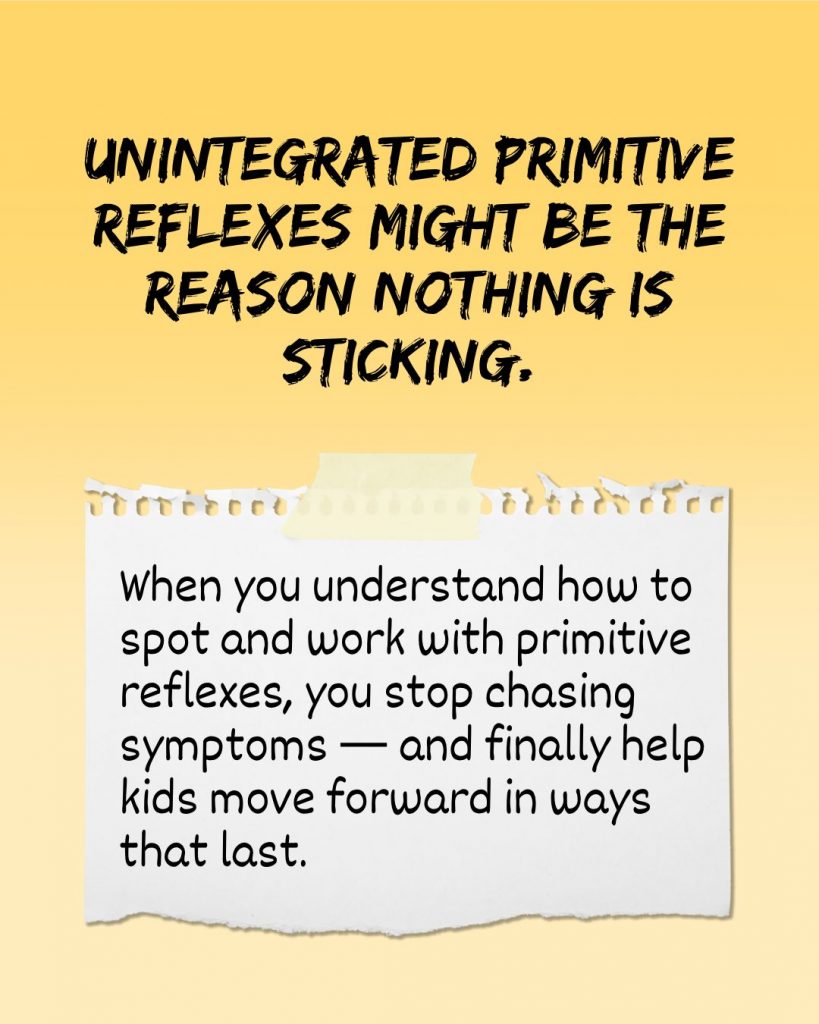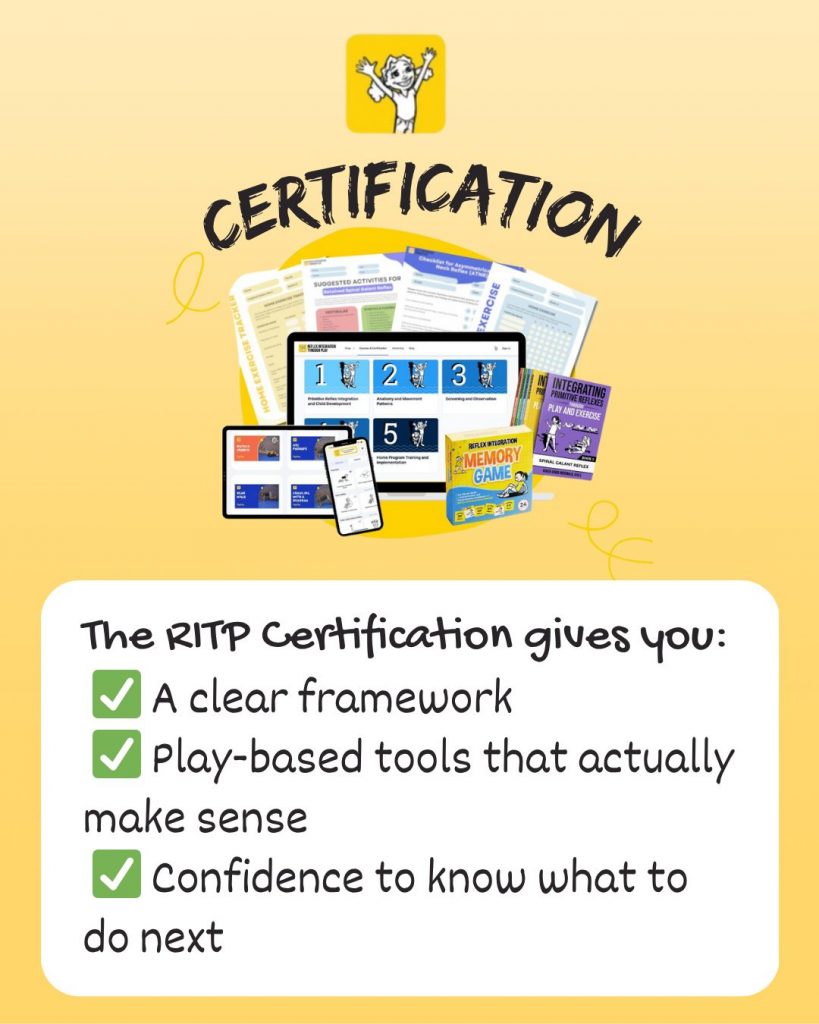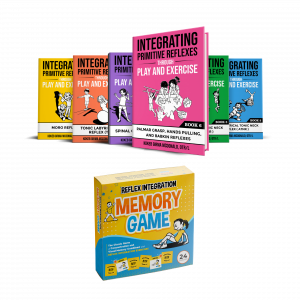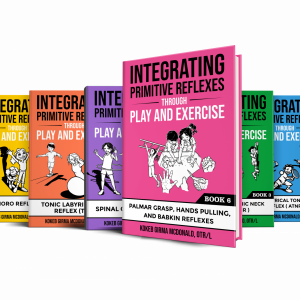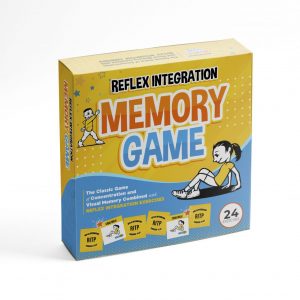Supporting Real-Life Skills Through Movement and Clinical Reasoning
As occupational therapists, our mission is to help clients meaningfully engage in daily life—whether that’s motor coordination, academic success, attention, emotional regulation, or sensory regulation. These are the functional goals we write and work toward.
To meet those goals, we need effective tools for treatment planning—and reflex integration is one of them.
Reflex Integration: More Than a Trend
Reflex integration is still new in many OT circles. It’s rarely emphasized in school curriculums, and many therapists aren’t confident applying it. But it’s not a standalone treatment— it’s a modality. A lens. A way to:
- Screen underlying patterns
- Understand developmental progression
- Address what’s impacting functional movement
At Reflex Integration Through Play (RITP), we teach therapists to use reflex integration as a means to an end.
The end is always improved functional skills: coordination, regulation, balance, motor planning, play, dressing, feeding, and more.
Our job is to figure out what’s getting in the way.
Breaking Down “Coordination Challenges”
If a client has “coordination challenges,” what does that really mean?
- Can’t clap to a beat?
- Trouble catching a ball?
- Difficulty alternating feet or staying seated?
Is it left-right integration? Top-bottom? Whole-body control? Instead of just naming the symptom, we ask why.
We look at brain-body communication and ask:
What foundational patterns might be underdeveloped or retained?
This is where reflex patterns matter.
Integrating Reflexes Is the Foundation—Efficient Movement Is the Goal.
We’re not chasing reflex integration as the goal. We’re studying how the body moves and what limits or supports efficient, functional movement.
Questions we ask include:
- What does functional movement look like?
- Which reflexes impact posture, balance, and coordination?
- Which muscle groups are—or aren’t—working together?
When you understand these patterns, treatment becomes clear and targeted.
What OT Sessions Actually Look Like
Let’s be real—our sessions are filled with play and movement:
- Rolling across mats
- Climbing swings
- Crawling through tunnels
- Jumping between stepping stones
But every activity is intentional—designed to build:
- Core strength
- Postural control
- Midline crossing
- Balance and coordination
It’s not random play—it’s purposeful movement-rich therapy.
Inside RITP: Building Strong Clinical Reasoning
Through the RITP framework, we train therapists to:
- Break down each activity into functional components
- Assess the child’s movement patterns
- Grade or adapt the task based on developmental needs
We use movement to teach. Functional skills are achieved through intentional, developmentally appropriate movement experiences.
What We Emphasize in the RITP Certification:
- How to observe and screen for reflex patterns connected to function
- How to create treatment plans that target whole-body development
- How to select purposeful play-based activities that enhance brain-body connection
- How to measure progress through improved function, not just reflex checklists
Unfortunately, one trend we see is therapists hyper-focusing on just a few reflexes, isolating them without context, and writing goals that sound like: “Client will integrate ATNR.” But that misses the mark. It can lead to overly narrow treatment, subjective assessments, unmet functional goals, and limited carryover.
Avoiding Common Mistakes
A common mistake? Writing goals like:
“Client will integrate ATNR.“
This is too narrow and not tied to function. Instead, we write goals that support:
- Maintaining seated attention and body awareness during class
- Increasing independence in self-care like dressing or hygiene
- Improving emotional regulation in social and academic settings
- Enhancing bilateral coordination and whole-body movement
- Engaging meaningfully in routines, play, and peer interaction
We then teach our therapists how to address challenging areas through purposeful, play-based interventions that are developmentally appropriate and age-specific—always with the goal of improving real-life function.
So yes, reflex integration matters and when done well, it becomes a bridge between movement, connection, and real-world functional gains.
Reflex integration is not a destination. It’s a pathway that supports connection, movement, and real-life gains.
If you ever felt unsure how to bridge theory to practice, or want to move beyond the checklist and guessing and into confident clinical reasoning, RITP is here to guide you..

